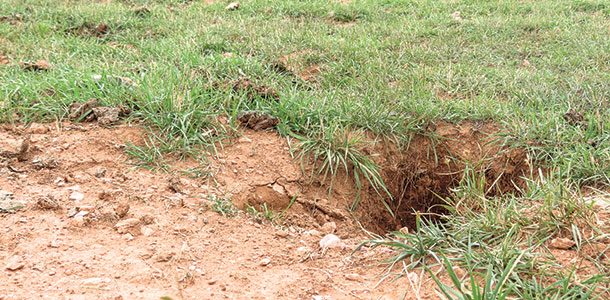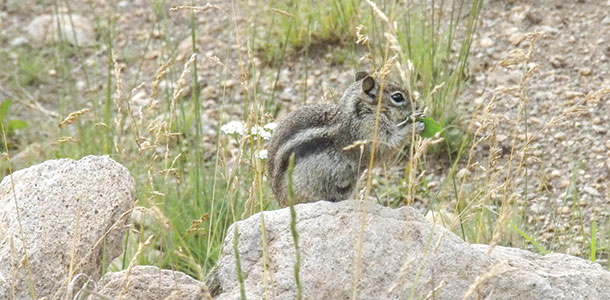Whether they are prairie dogs, pocket gophers or some type of ground squirrel, these pesky rodents can reduce forage productivity as well as create a dangerous situation for cattle and horses.
With holes ranging anywhere from 2 to 12 inches in diameter – depending on the size and the type of rodent – ranchers have ample reasons to be concerned.
But by using the proper control methods and understanding the ecology and the nature of the animal, ranchers will be better able to utilize their time and money in their managing efforts.
Frank Bloom, a cow-calf producer in Scenic, South Dakota, says he lives in an area where prairie dog infestations are prevalent. In an effort to slow down the population, Bloom sets aside time each spring to scout more than 600 acres for prairie dog towns and apply a form of poison bait such as zinc phosphide or Rozol at each site.
But without the same determination to control the prairie dog problem on his neighboring government ground, any headway Bloom gets that year usually ends up with a new set of migrating prairie dogs from the neighboring property.

“It can be frustrating,” Bloom says. “These prairie dogs will come in and pretty much ruin a chunk of ground until there is no vegetation left on it. And not only that, every time they a dig a hole it is a detriment to our livestock.
Those holes are very dangerous when we are out there on horseback trying to gather cattle; one wrong step and we are out a three- to five-thousand-dollar horse.”
A competition for forage
Roger Baldwin, a cooperative extension specialist within the department of wildlife, fish and conservation biology at the University of California – Davis, agrees that burrowing rodents pose a safety threat to livestock, but he believes the bigger threat lies with the reduction in forage.

According to the Vertebrate Pest Control Research Advisory Committee (VPCRAC), ground squirrels in particular reduce the amount of forage for cattle during the winter months when forage production is slow.
In one study, researchers found that 20 ground squirrels eat as much as one sheep, and about 200 ground squirrels eat as much range forage as one 1,000-pound steer.
However, the loss of forage isn’t as noticeable to ranchers during years of adequate rainfall. It is during a drought that ranchers recognize the competition between livestock and ground squirrels for available forage, VPCRAC says.
It’s hard to determine exactly how much of an impact burrowing rodents can have on livestock – especially when it comes to weight gain, Baldwin says. It can depend on a number of conditions – such as the site, number of rodents and the amount of livestock grazing in the particular area.
For this reason, it has been a controversial topic within the beef industry for several years.
Baldwin also points out that for those ranchers that grow their own hay, some burrowing rodents can damage the quality of hay along with hay equipment.
Gophers in particular create large mounds at the opening of the tunnel system that can be picked up when cutting or baling hay – reducing quality. He recommends implementing a zero-tolerance policy, or as close to that as possible, if trying to harvest hay or alfalfa for livestock.
“It depends on the situation whether or not you should implement control practices,” Baldwin says. “It’s almost impossible to completely eradicate rodents from your property, assuming that you have a neighboring property that doesn’t use control.
I think if you are in a manageable situation, it can be worthwhile in many cases, especially in cropfields.”
Options for control
Baldwin suggests implementing control practices where ground squirrels are abundant. He says the most effective and most practical method is bait application, which is also recommended for other rodent species as well.
There are several different types of poison baits, but not all are legal in every state and some shouldn’t be applied at certain times of the year. It is important to do some research and check with the local extension agent before applying poison bait, he says.
Depending on the amount of time and money a rancher is willing to put into managing burrowing rodents, there are several options available. It is important ranchers distinguish the severity of the rodent problem and determine which method will best work for their operation, he says. Below are a few alternative control methods:
-
Fumigants: This method releases a toxic gas into the burrow system. For the fumigant method to be effective, every opening in the burrow system has to be covered to contain the poison gas – making it more labor-intensive than poison bait application.
This method can be a good follow-up method for poison bait application or used on its own, but it is typically more costly and requires more time than other control methods. However, with the right equipment, it can be very effective and usable on a larger scale.
-
Trapping: This method is practical when the population of rodents is low to moderate. Typically, this method is best used to control gophers because they isolate themselves in their tunnels. The trap should be placed inside the opening of the tunnel system for the gopher to enter.
The benefit of trapping is the rancher has a proof of death; however, this method might require a significant amount of time to eliminate the problem on a vast amount of ground. Controlling prairie dogs and squirrels with trapping could be difficult because there are multiple animals per tunnel.
It is also important the person trapping uses protective gear so diseases that are customary to these animals are not passed on.
- Shooting: Shooting can be a useful control method if the rancher is devoted and determined to reduce the population. However, it can also be timely and costly if there is a lot of acreage to cover. This is only recommended if the rancher is in a rural location and if the population is low.
Is it worth the labor and the cost?
Dwayne Elmore, an extension wildlife specialist at Oklahoma State University, recommends assessing the damage caused by rodents and then determining if there will be a return on investment before making any management decisions.
“A lot of the control that is applied is not cost-effective,” Elmore says. “It is a situational thing. Look at your situation on a case-by-case basis. Ask a lot of questions and make sure you ask the right questions.
Because a lot of the time people will stop at ‘How do I control this issue?’ That is not the only question you should be asking. Rather, ask yourself ‘How long is it going to last, and can I pay or make up for what it will cost?’”
Elmore points out that rodent management can be very labor-intensive and expensive in some situations. It is important ranchers understand the task at hand before they invest too much time and effort into managing the population, especially on large rangelands.
Ranchers should talk with their local extension agent to learn more about the control options available in their area and to discuss the pros and cons of rodent management. ![]()
Cassidy Woolsey is a freelance writer based in Utah.
PHOTOS
PHOTO 1: The most common species of prairie dog is the black-tailed prairie dog. It is scattered throughout the Great Plains. Photo courtesy of Dwayne Elmore.
PHOTO 2: Holes like these can create a hazardous situation for cattle and horses. However, the chances of an animal injuring or breaking a leg in one of these holes is uncommon, Elmore says. Photo courtesy of Cassidy Woolsey.
PHOTO 3: There are many species of ground squirrels throughout the U.S. Photo courtesy of Dwayne Elmore.







